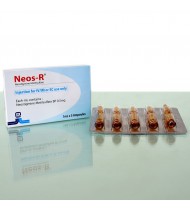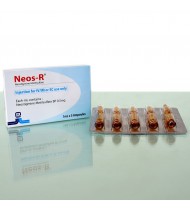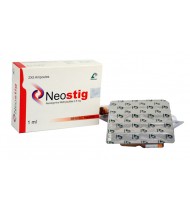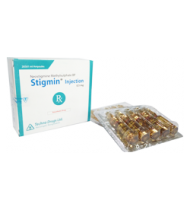Neostigmine Methyl Sulphate
Indications
Neostigmine Methyl Sulphate is indicated for-
- Reversal of nondepolarising neuromuscular blockade for surgical anesthetic procedures
- The prevention and treatment of post-operative abdominal distention and urinary retention after mechanical obstruction has been excluded.
- Treatment of the systemic control of Myasthenia Gravis when oral therapy is impractical.
Pharmacology
Neostigmine is a parasympathomimetic, specifically, a reversible cholinesterase inhibitor. By interfering with the breakdown of acetylcholine, Neostigmine indirectly stimulates both nicotinic and muscarinic receptors. It does cross the blood-brain barrier but only poorly. Neostigmine binds to the anionic site of cholinesterase. The drug blocks the active site of acetylcholinesterase; so the enzyme can no longer break down the acetylcholine molecules before they reach the postsynaptic membrane receptors. This allows for the threshold to be reached so a new impulse can be triggered in the next neuron. In myasthenia gravis there are too few acetylcholine receptors. So with the acetylcholinesterase blocked, acetylcholine can bind to the few receptors and trigger a muscular contraction.
Dosage & Administration
Reversal of the effects of Non-depolarizing Neurormuscular Blocking Agents: The usual dose is 0.5 to 2 mg given by slow intravenous injection over 60 seconds; repeated as required. Total dose should not exceed 5 mg (in exceptional cases). When Neostigmine is administered intravenously, it is recommended that Atropine Sulphate (0.6-1.2 mg) also be given intravenously using separate syringe.
Prevention of post-operative abdominal distention and urinary retention: 0.25 mg intramuscularly or subcutaneously as soon as possible after operation; repeat every 4 6 hours for 2-3 days.
Treatment of post-operative abdominal distention: 0.5 mg intramuscularly or subcutaneously or as required.
Treatment of urinary retention: 0.5 mg intramuscularly or subcutaneously. If urination does not occur within an hour, the patient should be catheterized. After the patient has voided, or the bladder has been emptied, continue the 0.5 mg injection every 3 hours, for at least 5 injections.
Symptomatic control of Myasthenia Gravis: 0.5 mg intramuscularly or subcutaneously. Subsequent dose should be based on the individual patient's response.
Neonates: 50-250 micrograms (0.1 to 0.5 ml) every 4 hours.
Children: 200-500 micrograms (0.4 ml to 1 ml) as recommended.
Prevention of post-operative abdominal distention and urinary retention: 0.25 mg intramuscularly or subcutaneously as soon as possible after operation; repeat every 4 6 hours for 2-3 days.
Treatment of post-operative abdominal distention: 0.5 mg intramuscularly or subcutaneously or as required.
Treatment of urinary retention: 0.5 mg intramuscularly or subcutaneously. If urination does not occur within an hour, the patient should be catheterized. After the patient has voided, or the bladder has been emptied, continue the 0.5 mg injection every 3 hours, for at least 5 injections.
Symptomatic control of Myasthenia Gravis: 0.5 mg intramuscularly or subcutaneously. Subsequent dose should be based on the individual patient's response.
Neonates: 50-250 micrograms (0.1 to 0.5 ml) every 4 hours.
Children: 200-500 micrograms (0.4 ml to 1 ml) as recommended.
Interaction
Anti-arrhythmic Procainamide, Quinidine and possibly Propafenone antagonise effect of Neostigmine. Antibacterials, Aminoglycosides, Clindamycin, Lincomycin and Polymyxins antagonise effect of Neostigmine.
Contraindications
Neostigmine is contraindicated in patients with known hypersensitivity to the drug. It is also contraindicated in patients with peritonitis or mechanical obstruction of the intestinal or urinary tract.
Side Effects
Nausea, vomiting, increased salivation, diarrhoea and abdominal cramps (more marked with high doses). Signs of overdose are increased gastrointestinal discomfort, bronchial secretions and sweating, involuntary defecation and micturition, miosis, nystagmus, bradycardia, hypotension, agitation, excessive dreaming and weakness eventually leading to fasciculation and paralysis.
Pregnancy & Lactation
Pregnancy Category C. There are no adequate or well-controlled studies of Neostigmine in either laboratory animals or in pregnantwomen. It is not known whether Neostigmine can cause fetal harm when administered to a pregnant woman or can affect reproductive capacity. Neostigmine should be given to a pregnant woman only if clearly needed.
Nonteratogenic Effects: Anticholinesterase drugs may cause uterine irritability and induce premature labor when given intravenously to pregnant women near term.
Nursing Mothers: It is not known whether Neostigmine is excreted in human milk. Because many drugs are excreted in human milk and because of the potential for serious adverse reactions from Neostigmine in nursing infants, a decision should be made whether to discontinue nursing or to discontinue the drug, taking into account the importance of the drug to the mother.
Nonteratogenic Effects: Anticholinesterase drugs may cause uterine irritability and induce premature labor when given intravenously to pregnant women near term.
Nursing Mothers: It is not known whether Neostigmine is excreted in human milk. Because many drugs are excreted in human milk and because of the potential for serious adverse reactions from Neostigmine in nursing infants, a decision should be made whether to discontinue nursing or to discontinue the drug, taking into account the importance of the drug to the mother.
Precautions & Warnings
Asthma, bradycardia, recent myocardial infarction, epilepsy, hypotension, parkinsonism, vagotonia, peptic ulceration. Atropine or other antidote to muscarinic effccts may be necessary (particularly when Neostigmine is given by injection), but it should not be given routinely as it may mask signs of overdose.
Therapeutic Class
Anti-cholinesterases, Drugs used in Myasthenia Gravis
Storage Conditions
Store in a cool and dry place, protected from light.
Neos-R Injection 1 ml ampoule
IndicationsNeostigmine Methyl Sulphate is indicated for-Reversal of nondepolarising neuromuscular bl..
8.00Tk.
Neos-R Injection 5 ml ampoule
IndicationsNeostigmine Methyl Sulphate is indicated for-Reversal of nondepolarising neuromuscular bl..
35.00Tk.
Neostig Injection 1 ml ampoule
IndicationsNeostigmine Methyl Sulphate is indicated for-Reversal of nondepolarising neuromuscular bl..
6.07Tk.
Stigmin Injection 0.5 mg/ml
IndicationsNeostigmine Methyl Sulphate is indicated for-Reversal of nondepolarising neuromuscular bl..
7.00Tk.
Showing 1 to 4 of 4 (1 Pages)




